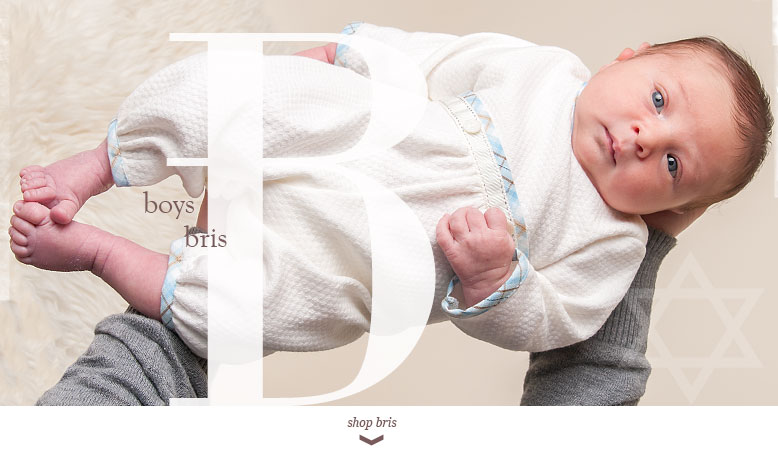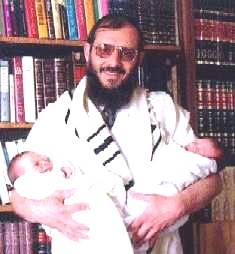by Sam Glaser
 What did the moel bring to the bris?
What did the moel bring to the bris?
A bris-kit!
There has been a bumper crop of baby boys in the Pico-Robertson shtetl this last month. It dawned on me that there are two lifecycle occasions that involve the whole community. Bar/Bat Mitzvahs and Weddings usually include a limited guest list. But for the bris and the funeral everyone is invited. We rally for the entrance and exit of a soul in this world. It is a profound mitzvah to attend either event even when you don’t know the family very well or at all, and is a rare opportunity to see the whole community together. Besides, you get a bagel, lox and cream cheese on the house!
The first bris of these recent smachot (celebrations) I attended involved a couple who has made the rounds through the forty odd synagogues within a mile of our home. Therefore we had an equal representation of Ashkenazim and Sephardim, Litvaks, Chabadniks and friends and relatives who awkwardly wore the black satin kippot provided. The Rebbe’s letter was recited, a Sephardic cantor wailed a priestly blessing in an eastern mode, the Beth Jacob rabbi did the kiddush and the food was Persian. There was a definite feeling of deep unity and intense joy for this couple bringing their first child into the world.
My rabbi advised that when one is at a bris, the second the incision is made is a powerful time to pray as it is a moment of intense compassion that is raining down from above. I was standing in a prime spot right by the ark. I hid my face in the velvet curtain as the tears streamed down. I prayed for the well being of this child and his family and then the well being of my children and my extended family. I suddenly felt overwhelmed by the fragility of life and the ever racing life-clock. I saw the face of my loving father who wants to give me so much love and spend time with my family and is in ever increasing pain. I saw my oldest son who is about to turn eighteen and wander the globe as a life force independent of the nest in which we have nurtured him. I felt the irony that his bris and pidyon haben (redemption of the first born) were just YESTERDAY! People were looking at me quizzically, Did I know this family so well that I was rendered an emotional basket case over this rite of passage?
 Two days later came the fancy bris of the month. All of the neighborhood big shots were assembled and it was anyone’s guess which bearded sage would be graced with the highest honor of sandek, the person who holds the baby in his lap during the ceremony. It was the father’s fourth child but he was as touched as if it were his first. His beautiful wife sobbed as she looked on. Amidst the pomp and circumstance of this first class affair there was still a simple presence of the Shechina and sure enough I found myself getting misty eyed once again. I was still wearing my tallis and tefillin from Shachrit and even though I had prayed in rote fashion, the power of the words I had already uttered somehow landed in my atria at the moment of the incision. One lesson learned: most attendees come for the mitzvah and not the meal. The ample delicacies were artfully displayed in stations across the vaulted lobby of the Museum of Tolerance and yet about 10% was eaten by the time the room cleared out.
Two days later came the fancy bris of the month. All of the neighborhood big shots were assembled and it was anyone’s guess which bearded sage would be graced with the highest honor of sandek, the person who holds the baby in his lap during the ceremony. It was the father’s fourth child but he was as touched as if it were his first. His beautiful wife sobbed as she looked on. Amidst the pomp and circumstance of this first class affair there was still a simple presence of the Shechina and sure enough I found myself getting misty eyed once again. I was still wearing my tallis and tefillin from Shachrit and even though I had prayed in rote fashion, the power of the words I had already uttered somehow landed in my atria at the moment of the incision. One lesson learned: most attendees come for the mitzvah and not the meal. The ample delicacies were artfully displayed in stations across the vaulted lobby of the Museum of Tolerance and yet about 10% was eaten by the time the room cleared out.
The foreskin trifecta continued with a sweet friend from a shteibl (small synagogue) across the street from my house. Again, I was surprised by my potent reaction to this ancient ceremony. Perhaps it was the sight of the new father surrounded by his five brothers saying kaddish for their recently departed father. Perhaps it was the fact that the baby’s name was going to keep in life the name of the grandpa he would never know. Such sadness and joy combined in a single moment and there I was again, an emotional wreck!
The brit milah ceremony is nothing short of a miracle. The newborn child continues a chain of tradition that has been passed down for thousands of years since the circumcision of Avraham. The Jewish People have kept alive this controversial practice of “infant mutilation” in the face of admonishment and worse from the nations around us. This practice especially angered the Greeks who were advocates of the body beautiful. How dare this stubborn tribe do surgery on a perfect child? But the Jews prevailed, and so did their mission of serving as God’s partners in the perfection of the world. We take matters into our own hands. There is pain and suffering in the world because the world is an imperfect place that humanity must improve. A primary source of the shortcoming of our grand civilization is in the misdirection of our animal drives. No wonder it is on the very organ of our drive that we inscribe the seal of the covenant.
 There is special significance in the fact that we are commanded to carry out this holy procedure on the eighth day. Kabbalah teaches that seven is the number associated with the intersection of the human sphere and the divine. That is why our weekly communion with our Creator and Redeemer, the Sabbath, is every seventh day. Eight is one step beyond, entirely metaphysical, the realm of the supernatural. It is interesting that eight is simply the vertical representation of the universal symbol for infinity. Eight is also the number associated with Chanukah where we celebrate the miraculous victory of the Maccabees and the length of time that the single cruse of oil burned. Some say that the miracle of Chanukah is the fact that we bothered to try to light the menorah or fight the Syrian-Greeks in the first place. After all, isn’t it wiser to surrender when all the chips are down, when defeat is inevitable? NO, says Jewish tradition. That is precisely when we must remember that we are a supernatural people that defies all laws of conventional sociology and, with God’s help, we are invincible.
There is special significance in the fact that we are commanded to carry out this holy procedure on the eighth day. Kabbalah teaches that seven is the number associated with the intersection of the human sphere and the divine. That is why our weekly communion with our Creator and Redeemer, the Sabbath, is every seventh day. Eight is one step beyond, entirely metaphysical, the realm of the supernatural. It is interesting that eight is simply the vertical representation of the universal symbol for infinity. Eight is also the number associated with Chanukah where we celebrate the miraculous victory of the Maccabees and the length of time that the single cruse of oil burned. Some say that the miracle of Chanukah is the fact that we bothered to try to light the menorah or fight the Syrian-Greeks in the first place. After all, isn’t it wiser to surrender when all the chips are down, when defeat is inevitable? NO, says Jewish tradition. That is precisely when we must remember that we are a supernatural people that defies all laws of conventional sociology and, with God’s help, we are invincible.
King Solomon tried every lifestyle, every vice, every excess. At the end of his masterpiece “Kohelet,” his refrain is that there is nothing new under the sun. And so we see in our media that the same thing gets regurgitated time and time again. How many bands are still trying to top Sgt. Peppers? How many TV reality shows are exploiting different angles of the same plot? How many episodes of James Bond will we pay to see? I remember my first year in yeshiva: Every time I came up with what I thought was a novel question, I found out that the sages had been debating it for millennia. So where is there newness? Are we doomed to life spinning on a hamster wheel? The fact is that there is newness ABOVE the sun, in other words, in the realm of the supernatural. And that is where the Jewish People reside–in a celestial realm of membership in an eternal tribe that is ever closer to the goal of tikkun olam, the perfection of the world.
So when you celebrate a bris, know that it is actually a profound journey into the fundamentals of eternity. Next time you hear that eight-day-old baby boy cry, ponder for a moment the preciousness of your place in history, that YOU are part of this chain, part of this miraculous people, a partner with God in the creation of the universe. We have the chance to serve as God’s hands in this world. We commit this strange act of elective surgery on a perfectly healthy baby that has NO SAY whatsoever in the act. And when the enemies of the Jewish people, even “enlightened” Jews that don’t quite get it, try to stop this “barbaric practice,” we must stand proudly by our generations that have sacrificed their lives to keep these sacred customs alive.
Most importantly, at that moment of the surgery, feel the presence of Eliyahu – Elijah, who attends every bris and will attend our eventual redemption. Know that the pain that the baby is feeling, and the pain that we have experienced as a people is all for the good, all for a reason, all going towards a holy goal. And savor that moment of closeness with our empathetic Creator, who loves us more than our parents, who feels our pain and who is our partner in everything that we accomplish. Now you know what to pack in your bris-kit.
Tags: bris, brit milah, circumcision, daven, eliyahu, foreskin, Jewish Music, moel, mohel, Sam Glaser